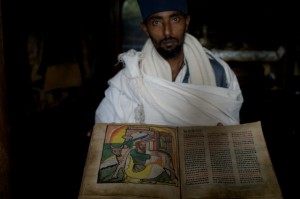Lalibela Mountains
7 March. Sunday. Lalibela is high and surrounded by spectacular arid mountains that are sparsely covered with grasses, brush, and the occasional grove of trees or bamboo (the latter only in protected locations near water sources). The town itself sits at over 2, 500 meters and the surrounding mountains range upwards of 3500 meters. Today I joined a UNESCO worker and a Berkely PhD student (Chloe and Alex), both based in Paris, to hike to 3, 200 meters (about 25km round trip). We will see a mountain village (Asheton), rock-hewn church, and monastery.
We started at 7:20 am to beat the heat of the day. The going was tough: the switch-backing trail was uneven, often very steep and rutted, and strewn with loose rocks. At the outset it was also busy with people (all locals except for the three of us) and livestock. Often we waited for those with heavy loads to negotiate steep sections. Falling would result in a dangerous, long tumble. At one point everyone was forced to scrambled aside when two men dropped the long, heavy Eucalyptus pole they were carrying between them. They shouted a warning in Amharic and the log careened down the steep slope, crossing the switch-backs and nearly missing children and those with heavy loads who couldn’t raise their heads to see it coming and get safely to the side. The notion of hiking for the sake of hiking is certainly odd in this place where walking such a mountain trail is done with purpose: getting one’s goods down to market, getting to school or church, etc.
The village was quiet on this Sunday as we passed through at 8:30am, its inhabitants have long since departed for the fields or town. Beyond it the trail was quiet and at times exposed, cut into the side of the cliff face with a long drop to terraced fields below. Most remarkable about this area is the way in which every possible patch of arable land is put to use. Terraces are carved into the most unlikely, steep faces. It is the dry season, and there is nothing growing here now, but in June, July and August, our guide Destow remarked, this area is green and fertile.
We are the only foreigners at the rock-hewn church. It is partially collapsed and, like some of its counterparts in Lalibela, is sheltered by a protective covering meant to keep the rains off the sandstone. Nonetheless, it is impressive, both in its architecture and its stunning location, perched as it is on a jutting rock over the valley, with a sheer drop of several hundred feet on three sides. One is wise to stay back from the precipice.

The monastery, to which we carry on, is some four kilometres down a steep path on the other side of the mountain, nested in a natural cave that is home to hundreds of birds that serenade visitors resting in the chanting room. All of these places are home to relics – remarkable manuscripts of vellum in Ge’ez and old crosses, mostly — which the priests willingly bring out for the perusal of visitors. The manuscripts are particularly stunning, although I often find myself wondering about their preservation — and then, catching myself, about whether preservation is an appropriate concern in this context. How does one balance matters of preservation with the fact that these artefacts are central to the daily goings-on of active places of worship at the heart of these mountain communities? When our guides speak of the unnatural nature of the large, modern coverings UNESCO erected over the rock-hewn churches in the Lalibela town site last year, it is clear that this debate over preservation at the expense of the local culture is ongoing within the community.